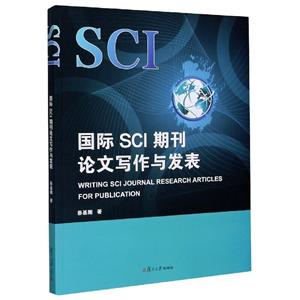扫一扫
关注中图网
官方微博
本类五星书更多>
-
>
心灵元气社
-
>
县中的孩子 中国县域教育生态
-
>
(精)人类的明天(八品)
-
>
厌女(增订本)
-
>
这样学习才高效/杨慧琴
-
>
心理学经典文丛:女性心理学
-
>
中国文化5000年
国际SCI期刊论文写作与发表 版权信息
- ISBN:9787309151169
- 条形码:9787309151169 ; 978-7-309-15116-9
- 装帧:一般胶版纸
- 册数:暂无
- 重量:暂无
- 所属分类:>>
国际SCI期刊论文写作与发表 内容简介
本书主要采用的理论框架是语类分析、语域分析、元话语和脚手架等,并按理工医农等科期刊论文的共性即IMRD安排内容,分析语步语阶,以及辨认和分析与其对应的句法、时态和元话语手段等语言特征。本书共10个单元,除*后一个单元是论文举例,其他9个单元分别讨论如何快速汲取科技论文的主要信息,如何撰写引言部分和文献回顾,如何收集数据和设计方法,如何通过文字和图表有效呈现结果,如何通过解释发现和对比类似研究来突出研究价值,如何撰写论文摘要、标题和参考文献,以及如何投稿、发表等。
国际SCI期刊论文写作与发表 目录
Unit One Preparing for Writing Research Articles
1.1 Being familiar with the characteristics of RAs
1.2 Deciding on a topic
1.3 Formulating aproblem/hypothesis
1.4 Using databases for references
1.5 Writing a proposal
1.6 Knowing the macro-structure of RAs
1.7 Reading titles for prediction
1.8 Reading abstracts for main ideas
1.9 Reading the key sentences in the Introduction and Discussion sections
1.10 Suggested readings
Unit Two Writing an Introduction Section
2.1 The moves of an Introduction section
2.2 Writing the initial sentences to claim centrality
2.3 Indicating the gap to be filled
2.4 Expressing the objective/purpose
2.5 Postulating a hypothesis
2.6 Introducing the methods and structure of the article
2.7 Tenses used in the Introduction
2.8 Signal words and cohesive devices
2.9 Fixed expressions for centrality, gaps and purposes
2.10 Re-use language in the Introduction
2.11 Suggested readings
Unit Three Writing a Literature Review
3.1 The elements of a Literature Review
3.2 The order of past studies
3.3 The content to review
3.4 Critical reading of the past studies
3.5 Synthesizing the sources
3.6 Citation function
3.7 Citation types
3.8 Citation methods
3.9 Verbs used to report past studies
3.10 Verb tenses in citation
3.11 Attitude markers
3.12 Re-use language in the Literature Review
3.13 Suggested readings
Unit Four Writing a Methods Section
4.1 The format of a Methods section
4.2 The elements of a Methods section
4.3 Study design
4.4 Describing the data and samples
4.5 Describing the materials
4.6 Describing the procedures
4.7 Research variables
4.8 Data analysis
4.9 Signal words for the purposes
4.10 Citations used in the Methods section
4.11 Active or passive verbs
4.12 Self-mention
4.13 Tenses in the Methods section
4.14 Suggested readings
Unit Five Writing a Results Section
5.1 The significance of the Results section
5.2 The choice of the data
5.3 The Contentof a Results section
5.4 The information elements Of the written part
5.5 The writing of the written part
5.6 The organization of results presentation
5.7 Data presentation
5.8 Designing and describing tables andfigures
5.9 Writing figUre legends and table titles
5.i0 Verb tenses and citations
5.! 1 FiXed expressions used in the Resuits section
5.12 Suggested readings
Unit Six Writing a Discussion Section
6.1 Writing a D~scussion section
6.2 The elements of a Discussion section
6.3 Highlighting the c0ntributi0n
6.4 Improving the chance' of being cited
6,5 Writing a C0nclusion
6.6 Hedging expressions
6.7 Attitude statements
6.8 Verb tenses
6.9 Fixed expressionS Used in the Discussion and Conclusion sections
6,10 Suggested readings
Unit Seven Writing an Abstract and a Title
7.1 Abstract
7.2 Verb tenses and self-mention in the Abstract
7.3 Fixed eXpression used in the Abstract
7.4 Keyords
7.5 Title
7,6 Supplemental information
7.7 Acknowledgments:
7,8 Author contributions
7.9 References
7.10 Suggested readings
Unit Eight Language and Style
8.i Style of scientific writing
8.2 The use of nominalizafion
8.3 Noun clusters
8.4 Impersonal structures
8.5 Subordinate structures
8.6 Modifier phrases
8.7 Lexical variation
8.8 Sentence variation
8.9 Using corpus analysis
8.10 Self-made CO~US
Unit Nine Preparing a Manuscript for Publication
9.1 Getting the paper published
9.2 Knowing the selection criteria of peer reviewers
9.3 Knowing the submission guidelines of a journal
9.4 Writing a cover;letter
9.5 Responding to the editors/peer reviewers
9.6 Writing a response letter
Unit Ten Reading Research Articles for Analysis
10.1 Effects of Communication About: Uncertaintv and Oncologist Gender on the
Physician-Patient RelationshiP
10.2 The Sound of Temperature: What Information Do Pouring Sounds Convey Concerning
the Temperature of a Beverage
10.3 DeepMood: Forecasting Depressed Mood Based on Self-Reported Histories Via
Recurrent NeUral Networks
10.4 Training End Users: An Experimental Investigation of the Roles of the Computer
Interface and Training MethodS
10.5 Changes in Diet and Lifestyle and Long-Term Weight Gain in Women and Men
10.6 Why Does Your Data Leak? Uncovering the Data Leakage in Cloud from Mobile Apps
10.7 Transfer Learning in Brain, Computer :InterfaCes
10.8 Patiromer Versus Placebo to Enable Spironolactone Usein Patients with Resistant
Hypertension and Chronic Kidney Disease (AMBER) A Phase 2, Rand0mised,
Double-Blind, Placebo-Controlled Trial
Appendixes
Appendix 1: Tables used in the book
Appendix 2: Course syllabus
Appendix 3: Course schedule
Appendix 4: ArtiCles :used as examples (AE)
References
Index
展开全部
书友推荐
- >
巴金-再思录
巴金-再思录
¥14.7¥46.0 - >
我从未如此眷恋人间
我从未如此眷恋人间
¥15.9¥49.8 - >
二体千字文
二体千字文
¥14.0¥40.0 - >
【精装绘本】画给孩子的中国神话
【精装绘本】画给孩子的中国神话
¥17.6¥55.0 - >
罗曼·罗兰读书随笔-精装
罗曼·罗兰读书随笔-精装
¥20.3¥58.0 - >
上帝之肋:男人的真实旅程
上帝之肋:男人的真实旅程
¥19.3¥35.0 - >
新文学天穹两巨星--鲁迅与胡适/红烛学术丛书(红烛学术丛书)
新文学天穹两巨星--鲁迅与胡适/红烛学术丛书(红烛学术丛书)
¥9.9¥23.0 - >
月亮虎
月亮虎
¥19.7¥48.0
本类畅销
-
古籍编辑工作漫谈(八品)
¥8.3¥16 -
上海档案史料研究(第二十一辑)
¥18.4¥58 -
科学研究的方法
¥19.5¥56 -
古典文献研究(第十二辑)
¥17.5¥50 -
劳沫之新闻文集
¥34.4¥88 -
编辑想要什么:科学期刊论文发表指南
¥14.2¥36





















